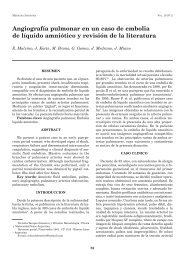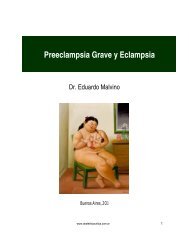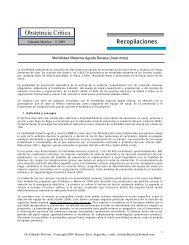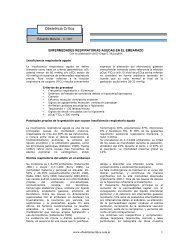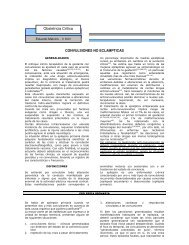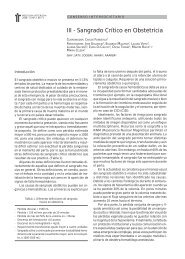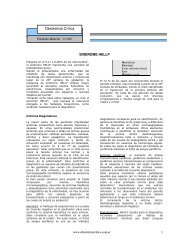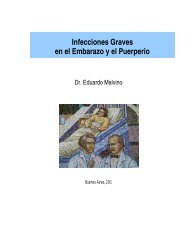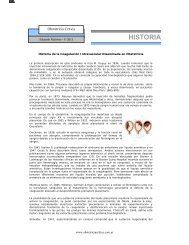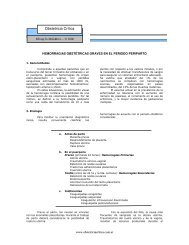J Reprod Med. 2007 Nov;52(11):1046-51.Pregnancy outcomes in women with chronic hypertension: a populationbasedstudy.Gilbert WM, Young AL, Danielsen B.Department of Obstetrics and Gynecology, University of California, Davis, USA.gilberw@sutterhealth.orgOBJECTIVE: To determine the pregnancy outcomes associated with maternalchronic hypertension. STUDY DESIGN: Retrospective, population-based cohortstudy of maternal and infant discharge records linked to birth records in Californiafrom 1991 to 2001 were examined for demographics and pregnancy outcomes,and comparisons were made between those with and without chronichypertension. One randomly selected pregnancy per subject was included.RESULTS: The number of women who delivered with chronic hypertension(0.69% incidence) was 29,842. As compared to non-chronic hypertensivepatients, fetal and neonatal mortality and in-hospital maternal mortality wereincreased (ORs and 95% CIs 2.3, (2.1, 2.6); 2.3, (2.0, 2.7); and 4.8, (3.1, 7.6)respectively). Major maternal morbidity was increased: stroke, OR 5.3, (3.7, 7.5);renal failure, OR 6.0, (4.4, 8.1); pulmonary edema, OR 5.2, (3.9, 6.7); severepreeclampsia, OR 2.7, (2.5, 2.9); and placental abruption OR 2.1, (2.0, 2.3).Neonatal morbidity was increased as well: fetal growth restriction, OR 4.9, (4.7,5.2); prematurity, OR 3.2, (3.1, 3.3); low birth weight, OR 5.4, (5.2, 5.5); very lowbirth weight, OR 6.5, (6.2, 6.8); and respiratory distress syndrome, OR 4.0, (3.8,4.2). CONCLUSION: Pregnant women with chronic hypertension havesignificantly increased risks of maternal and perinatal morbidity and mortality.Women with this condition should be treated as high risk with appropriatematernal and fetal surveillance.Am J Obstet Gynecol. <strong>2008</strong> Jan;198(1):56.e1-4.Hyperemesis in pregnancy: an evaluation of treatment strategies withmaternal and neonatal outcomes.Holmgren C, Aagaard-Tillery KM, Silver RM, Porter TF, Varner M.Department of Obstetrics and Gynecology, University of Utah Health SciencesCenter, Salt Lake City, UT, USA. cholmgren73@yahoo.comOBJECTIVE: The objective of the study was to evaluate the use of interventionssuch as a peripherally inserted central catheters (PICC) line or nasogastric(NG)/nasoduodenal (ND) tube with the use of medications alone in themanagement of pregnancies with hyperemesis. STUDY DESIGN: Subjects wereidentified with confirmed intrauterine pregnancy, admitted with hyperemesisgravidarum (HEG) between 1998 and 2004. Medical records were thenabstracted for information with regard to therapy. Subjects were assigned on thebasis of the management plan: medication alone, PICC line, or NG/ND tube.Outcomes were compared between groups. RESULTS: Ninety-four patients metstudy criteria and had complete outcome data available. Of those, 33 had a PICCline placed (35.1%), 19 had a NG/ND placed (20.2%), and 42 were managedwith medication alone (44.7%). These groups were similar with respect to
gestational age at delivery, Apgar score, and mean birthweight. Maternalcomplications were significantly higher among those with PICC lines. Of patientsmanaged with PICC lines, 66.4% (P < .001) required treatment for infection,thromboembolism, or both. Adjusted odds ratio for a PICC line complication was34.5 (5.09, 233.73). CONCLUSION: Maternal complications associated withPICC line placement are substantial despite no difference in neonatal outcomes,suggesting that the use of PICC lines for treatment of HEG patients should notbe routinely used.Am J Obstet Gynecol. <strong>2008</strong> Jan;198(1):75.e1-7.Prenatal health care beyond the obstetrics service: utilization andpredictors of unscheduled care.Magriples U, Kershaw TS, Rising SS, Massey Z, Ickovics JR.Division of Maternal-Fetal Medicine, Department of Obstetrics and Gynecology,Yale University School of Medicine, New Haven, CT 06520-8034, USA.urania.magriples@yale.eduOBJECTIVE: The objective of the study was to describe the patientcharacteristics of prenatal care utilization within and outside of routine obstetriccare, and the clinical and psychosocial factors that predict care utilization.STUDY DESIGN: Four hundred twenty pregnant women enrolled in arandomized controlled trial receiving prenatal care in a university-affiliated clinic.All hospital encounters were obtained by review of computerized databases. TheKotelchuck index (KI) was computed, and the characteristics of inadequate,adequate, or excessive prenatal care were described. Demographic andpsychosocial predictors of unscheduled visits were evaluated. RESULTS: A totalof 50.5% of women were adequate users by KI, with 19% being inadequate. Anaverage of 5 additional unscheduled encounters occurred (standard deviation4.2; range, 0-26). Almost 75% of participants made an unscheduled obstetricvisit, with 38% making 2 or more unscheduled visits. Overweight/obese, youngerwomen, high symptom distress, and excessive and inadequate prenatal userswere more likely to utilize the labor floor before delivery. CONCLUSION:Unscheduled care is common during pregnancy.Am J Obstet Gynecol. <strong>2008</strong> Jan 4 [Epub ahead of print]Maternal morbidity and infant death in twin vs triplet and quadrupletpregnancies.Luke B, Brown MB.University of Miami School of Nursing and Health Studies, Coral Gables, and theDepartments of Obstetrics & Gynecology and Pediatrics, Miller School ofMedicine, University of Miami, Miami, FL.OBJECTIVE: The purpose of this study was to calculate nationallyrepresentative, population-based estimates of maternal and neonatal risks intriplet and quadruplet pregnancies compared with twin pregnancies. STUDYDESIGN: The study population included 316,696 twin, 12,193 triplet, and 778quadruplet pregnancies from the 1995-2000 Matched Multiple Birth Data Set.Adjusted odds ratios (AORs) and 95% CIs estimated the risk of complications
- Page 1: Obstetricia CríticaEduardo Malvino
- Page 5 and 6: Maternal risk factors associated wi
- Page 7 and 8: exclusive categories: 1) bleeding r
- Page 9 and 10: Division of Obstetrics and Gynecolo
- Page 11 and 12: as uncommon as primary synovial sar
- Page 13 and 14: Cardiac Troponin I Elevation After
- Page 15 and 16: significant increase in carbohydrat
- Page 17 and 18: of one per 1500 pregnant women. Cal
- Page 19 and 20: Background: To investigate the rela
- Page 21 and 22: PowerLab hardware unit and Chart v3
- Page 23 and 24: Prophylactic antibiotics for the pr
- Page 25 and 26: years old (n = 23,921). Univariate
- Page 27 and 28: five women uses FDA C, D and X drug
- Page 29 and 30: and complicated. CONCLUSION: Irresp
- Page 31 and 32: clinically effective. Nevertheless,
- Page 33 and 34: Obstetrics and Gynecology Departmen
- Page 35 and 36: Pregnancy-induced severe gestationa
- Page 37 and 38: penicillin or ampicillin, whereas 3
- Page 39 and 40: Abetalipoproteinemia complicating t
- Page 41 and 42: case of acute abdominal pain, abdom
- Page 43 and 44: Callaway LK, Lawlor DA, McIntyre HD
- Page 45 and 46: ketoacidosis during induction of la
- Page 47 and 48: and low platelets (HELLP) syndrome.
- Page 49 and 50: Division of Reproduction and Endocr
- Page 51 and 52: simulation center, and to teamwork
- Page 53 and 54:
significantly associated with psori
- Page 55 and 56:
episiotomy and prophylactic oxytoci
- Page 57 and 58:
ecent obesity epidemic has had a pr
- Page 59 and 60:
guidelines in 2002. However, the di
- Page 61 and 62:
need for intensive neonatal care, h
- Page 63 and 64:
mEq/l) metabolic acidosis. Other et
- Page 65 and 66:
Acta Obstet Gynecol Scand. 2008;87(
- Page 67 and 68:
etrospective review of pregnancies
- Page 69 and 70:
Maternal obesity and pregnancy comp
- Page 71 and 72:
interval 3.78-5.30) and severe obst
- Page 73 and 74:
of GDM. Methods: 1,662 pregnant wom
- Page 75 and 76:
Registers. POPULATION: All pregnant
- Page 77 and 78:
J Reprod Med. 2008 May;53(5):365-8.
- Page 79 and 80:
egarding cervical cancer screening
- Page 81 and 82:
College of Surgeons in Ireland, Dub
- Page 83 and 84:
maternal morbidity has increased bo
- Page 85 and 86:
increased uterine activity was rela
- Page 87 and 88:
options.Journal of Perinatology adv
- Page 89 and 90:
atio, 1.73; 95% CI, 1.11-2.69). Thi
- Page 91 and 92:
discharge at site of perineal repai
- Page 93 and 94:
Thirty-one other patients refused t
- Page 95 and 96:
Department of Obstetrics and Centre
- Page 97 and 98:
developed any new problems. CONCLUS
- Page 99 and 100:
It seems to be safe to continue bre
- Page 101 and 102:
colonization in a subsequent pregna
- Page 103 and 104:
Crude and adjusted odds ratios were
- Page 105 and 106:
the subsequent development of ESRD.
- Page 107 and 108:
Acta Obstet Gynecol Scand. 2008 Sep
- Page 109 and 110:
OBJECTIVE: To investigate pregnancy
- Page 111 and 112:
OBJECTIVE: To compare the perinatal
- Page 113 and 114:
exceptionally rare. CASE: A 23-year
- Page 115 and 116:
CONCLUSION: This case demonstrates
- Page 117 and 118:
peripartum hysterectomy included ce
- Page 119 and 120:
BMJ. 2008 Sep 8;337:a1397. doi: 10.
- Page 121 and 122:
Lancet. 2008 Sep 17. [Epub ahead of
- Page 123 and 124:
Obstet Gynecol. 2008 Oct;112(4):951
- Page 125 and 126:
Additionally, the effects of distur
- Page 127 and 128:
analyzed. Initial echocardiographic
- Page 129 and 130:
pathologic or anatomically anomalou
- Page 131 and 132:
Eur J Obstet Gynecol Reprod Biol. 2
- Page 133 and 134:
chorioamnionitis; and (3) in contra
- Page 135 and 136:
underlying conditions related to st
- Page 137 and 138:
third trimester of pregnancy.BMJ. 2
- Page 139 and 140:
Texas Health Science Center, Housto
- Page 141 and 142:
preterm birth before 34 weeks (P
- Page 143 and 144:
cases. Most patients (91%) received
- Page 145 and 146:
Ultrasound Obstet Gynecol. 2008 Nov
- Page 147 and 148:
Maggard MA, Yermilov I, Li Z, Magli
- Page 149 and 150:
Clinical and Population Health, Per
- Page 151:
the biologic mechanism is unclear,



